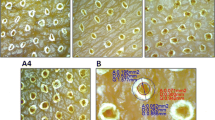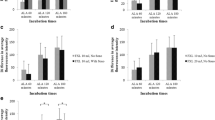Abstract
CO2 fractional laser, as an ablative fractional laser, is commonly used in cosmetic treatment. We applied CO2 fractional laser irradiation to skin in vitro and used reflectance confocal microscopy (RCM) to image and detect the presence of any non-ablative, micro-ablative and ablative effects, in order to better understand the features of a CO2 fractional laser. In vitro irradiation of foreskin was performed using a CO2 fractional laser. Foreskin specimens were divided into 4 groups that received different amounts of irradiation energy, based on the number of irradiation passes they received: 5, 10, 15, and 20 passes, respectively. This corresponds to fluence energy of 16.3, 32.6, 48.9, 65.3 J/cm2. Immediately after irradiation, digital microscopy (DM), RCM, and histopathology were performed to observe whether the non-ablative, micro-ablative, and ablative phenomenon occurred, and the injury features of MTZs. Immediately after CO2 fractional laser irradiation, RCM and DM showed that when the numbers of passes were 5 and 10, a micro-ablative column (MAC) could not be observed or was very small. We mainly observed a thicker thermal coagulation zone (TCZ), representing non-ablative or micro-ablative effects. When the number of passes were increased to 15 and 20, the MAC was significantly enlarged and surrounded by a TCZ of medium thickness, representing ablative effects. For the first time, this study used RCM and DM to demonstrate that a CO2 fractional laser could achieve non-ablative, micro-ablative, and ablative effects on irradiated skin via different energy levels.





Similar content being viewed by others
References
Anderson RR, Parrish JA (1983) Selective photothermolysis: precise microsurgery by selective absorption of pulsed radiation. Science 220(4596):524–527. https://doi.org/10.1126/science.6836297
Manstein D, Herron GS, Sink RK, Tanner H, Anderson RR (2004) Fractional photothermolysis: a new concept for cutaneous remodeling using microscopic patterns of thermal injury. Lasers Surg Med 34(5):426–438. https://doi.org/10.1002/lsm.20048
Omi T, Numano K (2014) The role of the CO2 laser and fractional CO2 laser in dermatology. Laser Ther 23(1):49–60. https://doi.org/10.5978/islsm.14-RE-01
Beasley K, Lii JMD, Brown P, Lenz B, Hivnor CM (2013) Ablative fractional versus nonablative fractional lasers-where are we and how do we compare differing products? Curr Derm Rep 2(2):135–143. https://doi.org/10.1007/s13671-013-0043-0
Hantash BM, Bedi VP, Kapadia B, Rahman Z, Jiang K, Tanner H, Chan KF, Zachary CB (2007) In vivo histological evaluation of a novel ablative fractional resurfacing device. Lasers Surg Med 39(2):96–107. https://doi.org/10.1002/lsm.20468
Hantash BH, Bedi VP, Chan KF, Zachary CB (2007) Ex vivo histological characterization of a novel ablative fractional resurfacing device. Lasers Surg Med 39(2):87–95. https://doi.org/10.1002/lsm.20405
Haak CS, Illes M, Paasch U, Hædersdal M (2011) Histological evaluation of vertical laser channels from ablative fractional resurfacing: an ex vivo pig skin model. Lasers Med Sci 26(4):465–471. https://doi.org/10.1007/s10103-010-0829-2
Uwe P, Merete H (2011) Laser systems for ablative fractional resurfacing. Expert Review of Medical Devices 8(1):67–83. https://doi.org/10.1586/erd.10.74
Xu XG, Luo YJ, Wu Y, Chen JZ, Xu TH, Gao XH, He CD, Geng L, Xiao T, Zhang YQ, Chen HD, Li YH (2011) Immunohistological evaluation of skin responses after treatment using a fractional ultrapulse carbon dioxide laser on back skin. Dermatol Surg 37(8):1141–1149. https://doi.org/10.1111/j.1524-4725.2011.02062.x
Shin MK, Choi JH, Ahn SB, Lee MH (2014) Histologic comparison of microscopic treatment zones induced by fractional lasers and radiofrequency. J Cosmet Laser Ther 16(6):317–323. https://doi.org/10.3109/14764172.2014.957216
Yue X, Wang H, Li Q, Li L (2017) Application of reflectance confocal microscopy to evaluate skin damage after irradiation with an yttrium-scandium-gallium-garnet (YSGG) laser. Lasers Med Sci 32(2):255–262. https://doi.org/10.1007/s10103-016-2106-5
Richters RJH, Hoogedoorn L, Uzunbajakava NE et al (2016) Clinical, biophysical, immunohistochemical, and in vivo reflectance confocal microscopy evaluation of the response of subjects with sensitive skin to home-use fractional non-ablative photothermolysis device. Lasers Surg Med 48(5):474–482. https://doi.org/10.1002/lsm.22486
Laubach HJ, Tannous Z, Anderson RR, Manstein D (2010) Skin responses to fractional photothermolysis. Lasers Surg Med 38(2):142–149. https://doi.org/10.1002/lsm.20254
Ross EV, Barnette DJ, Glatter RD, Grevelink JM (1999) Effects of overlap and pass number in CO2 laser skin resurfacing: a study of residual thermal damage, cell death, and wound healing. Lasers Surg Med 24(2):103–112. https://doi.org/10.1002/(sici)1096-9101(1999)24:2<103::aid-lsm5>3.0.co;2-b
Longo C, Galimberti M, De Pace B, Pellacani G, Bencini PL (2013) Laser skin rejuvenation: epidermal changes and collagen remodeling evaluated by in vivo confocal microscopy. Lasers Med Sci 28(3):769–776. https://doi.org/10.1007/s10103-012-1145-9
Banzhaf CA, Wind BS, Mogensen M, Meesters AA, Paasch U, Wolkerstorfer A, Haedersdal M (2016) Spatiotemporal closure of fractional laser-ablated channels imaged by optical coherence tomography and reflectance confocal microscopy. Lasers Surg Med 48(2):157–165. https://doi.org/10.1002/lsm.22386
Sattler ECE, Poloczek K, Kästle R, Welzel J (2013) Confocal laser scanning microscopy and optical coherence tomography for the evaluation of the kinetics and quantification of wound healing after fractional laser therapy. J Am Acad Dermatol 69(4):e165–e173. https://doi.org/10.1016/j.jaad.2013.04.052
Acknowledgments
Thanks for the China Medical Laser (Beijing) Technology Co., Ltd., for supplying the laser device.
Funding
This study was supported by the Open Research Fund Program of Beijing Key Lab of Plant Resource Research and Development, Beijing Technology and Business University.
Author information
Authors and Affiliations
Corresponding author
Ethics declarations
Conflict of interest
The authors declare that they have no conflict of interest.
Ethical approval
All procedures performed in studies involving human participants were in accordance with the ethical standards of the Beijing Tian Tan Hospital, Capital Medical University research committee and with the declaration of Helsinki.
Additional information
Publisher’s note
Springer Nature remains neutral with regard to jurisdictional claims in published maps and institutional affiliations.
Rights and permissions
About this article
Cite this article
Yue, X., Wang, H. Application of reflectance confocal microscopy to investigate the non-ablative, micro-ablative, and ablative effects of CO2 fractional laser irradiation on skin. Lasers Med Sci 35, 957–964 (2020). https://doi.org/10.1007/s10103-019-02910-5
Received:
Accepted:
Published:
Issue Date:
DOI: https://doi.org/10.1007/s10103-019-02910-5




